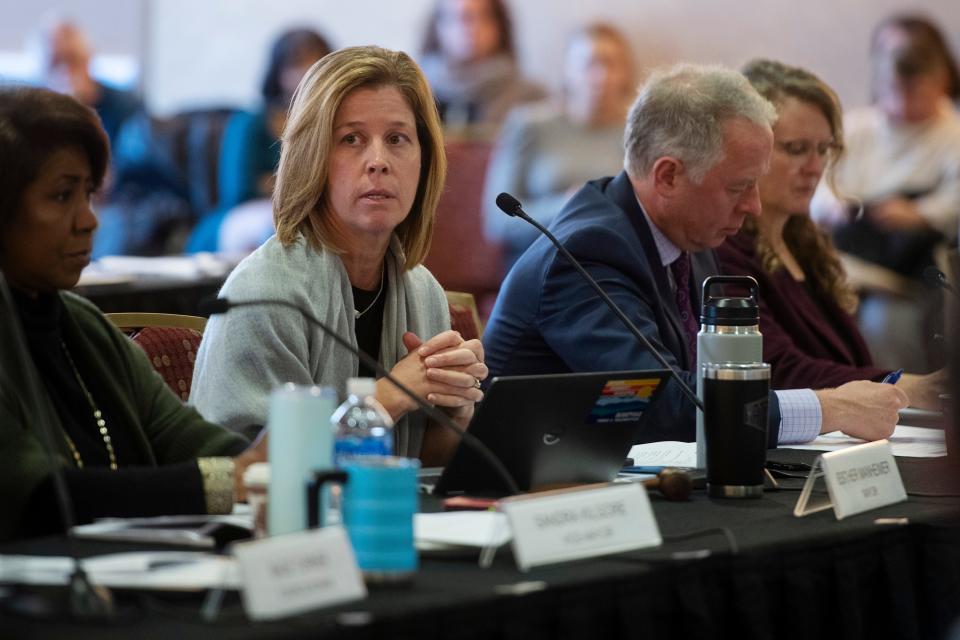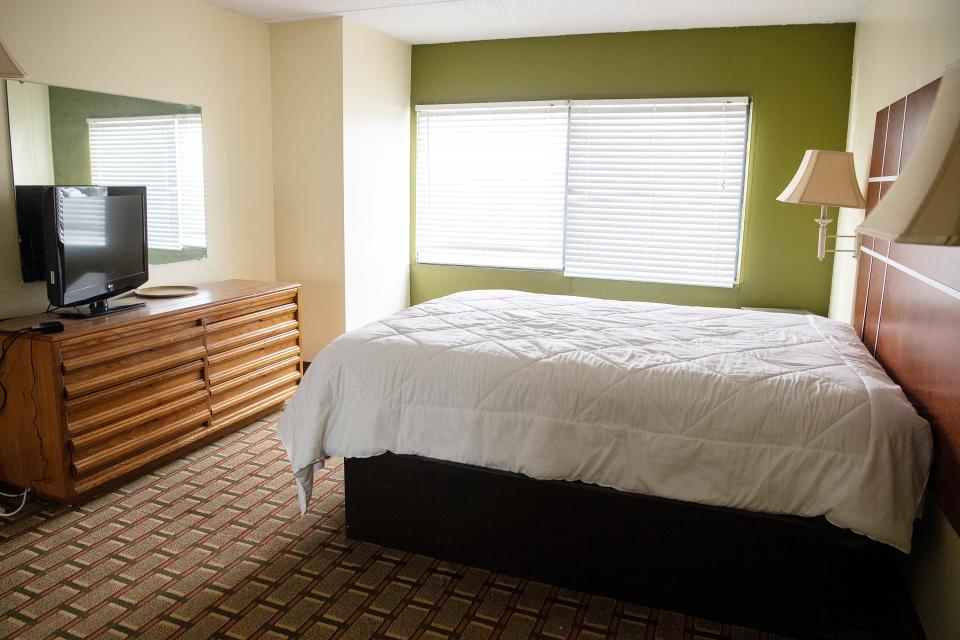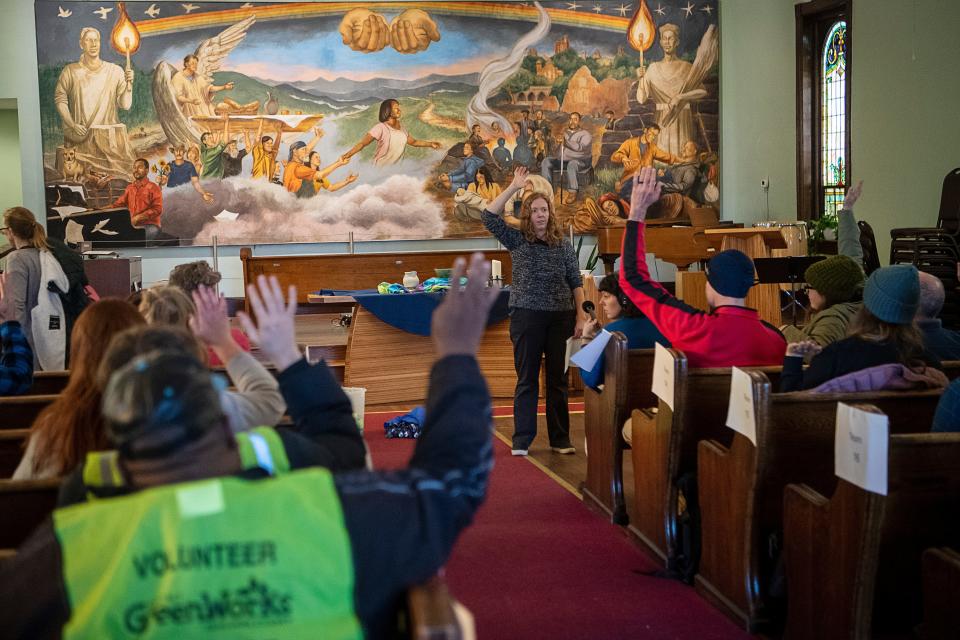Low-barrier homeless shelter on Asheville's horizon. But will it have council support?
ASHEVILLE - A new phase of homelessness response is beginning in Asheville: A network of citywide planning, reimagined. Meanwhile, City Council, until now signaling support behind a slate of recommendations from the National Alliance to End Homelessness, has seemingly begun to falter.
Hesitation is building, again, around the creation of a low-barrier shelter.
At its 14-hour, two-day council retreat in February, a majority of council members indicated an issue with placing support behind “full implementation” of the Alliance’s recommendations.
“What happens if there’s one we just really don’t agree with? I’ll go ahead and just signal that I’m having trepidation regarding the low-barrier shelter,” council member Antanette Mosley said. Without clarity around the proposed plan – which is still in process – she said she was not comfortable offering absolute support.
This was backed by council member Sage Turner and Vice Mayor Sandra Kilgore.
“I have concerns around that piece, as well,” Turner said. “It’s not just as simple to me to say, ‘thank you for this study, I agree with everything, go do it.’ I think there are too many layers of complication, community impact and funding."

Shifting city goals
The Alliance first presented its report to council and Buncombe County commissioners in January 2023. Among its top recommendations was the restructuring of the city and county’s Continuum of Care — which reached a milestone Feb. 29 with the first meeting of its new membership body — and increasing crisis response capacity, which includes growing the city’s shelter inventory.
“Homelessness Strategies” remains one of the city’s six strategic priorities, but in hashing out the “goals” of each priority, council pulled back from last year’s promise.
Rather than re-upping a goal of “mak(ing) homelessness rare, brief and non-recurring by supporting implementation of National Alliance to End Homelessness recommendations,” the language set in 2023, at its recent retreat, it was tweaked to read: “... targeting strategies recommended by the (Alliance).”
Council members Sheneika Smith and Maggie Ullman were also in favor of the language change.
"I don't hear anyone saying that they don't support the intentions or the goals, but there's a lot of detail yet to come," Ullman said.

At the retreat, Mayor Esther Manheimer — who has been vocal in support of low-barrier shelter, and council member Kim Roney — called the decision “concerning,” noting it re-positioned council to “vote no” when Alliance recommendations come to council in the future.
“If we don’t do the recommendations, centering the people most impacted, including our youth, and the equity lens that’s built into the report, we will still have a very big homelessness problem,” Roney said.
It’s not uncommon for elected bodies to adopt plans and then shelve them, she added later in a Feb. 28 conversation with the Citizen Times. But without following the recommendations – which were intended to cut unsheltered homelessness numbers in half by 2025 — then the city will end up with the same outcome: increased homelessness.
There are many reasons plans can change, “but I am concerned that it seems like we’re not all on the same page,” she said. “And it doesn’t mean we don’t want to address homelessness, we might just think there’s different ways of doing it.”
Asheville is in the midst of an ongoing homelessness crisis, exacerbated by the pandemic and climbing housing costs, and while overall numbers trended down last year, unsheltered counts remain higher than pre-pandemic figures, with 171 people experiencing unsheltered homelessness in Buncombe County, according to the January 2023 point in time count, an annual single night tally.
Buncombe County’s Homeless Program Manager Lacy Hoyle said in February they project unsheltered numbers will rise 3% this year, and continue to increase moderately, with an estimated 2030 count of 212 people.
What’s different this time?
The city attempted a low-barrier shelter project once before, at the former Ramada Inn, only to pivot away — assigning its purchase contract for the property to for-profit developer Shangri-La Industries, which promised more than 100 rooms of supportive housing. The project folded after foreclosure of the property late last year.
But this effort looks different. The request it makes of the city is not to be the organizing entity behind the shelter, but to be a partner in a unified, community effort. The county has already earmarked its final $3.8 million in ARPA funds for housing and shelter, with the possibility of dedicating it toward a low-barrier shelter facility.

The Ramada shelter was driven out of “sheer necessity,” Manheimer said, back in 2021 when shelters were closing or reducing capacity during the height of the pandemic. They went into it without a plan.
“Now we are methodically moving through each and every detail, and understanding all ways to do this, and being able to bring partners together,” Manheimer said. “Coupled with creation of the (Continuum of Care) and new governing structure, I think we’ve done everything we can do to set this up for success.”
Manheimer is one member of a shelter planning process, which began in fall 2023, along with City Manager Debra Campbell, County Manager Avril Pinder, Commissioner Jasmine Beach-Ferrara, and representatives from the Homeless Initiative Advisory Committee.
Manheimer's work studying area shelters, and touring shelters and service models elsewhere, began even earlier as part of an initial HIAC workgroup. The group’s efforts resulted in adding 43 new year-round shelter beds at existing shelters in Asheville, and recommended that HIAC partner with the city and county to plan a new low-barrier emergency shelter.
The new CoC, dissolving HIAC?
HIAC serves as the governing board for the Asheville and Buncombe County Continuum of Care, though pursuant to the Alliance’s recommendations, that is about to change — moving the board out from under the city and county, and creating a new governance structure.
A CoC is a self-governing, local planning body that works to build and oversee a coordinated response to homelessness. It's a framework overseen by the U.S. Department of Housing and Urban Development and is also necessary to become eligible for certain federal dollars.
As before, the city will still serve as the “lead agency” — meaning it will serve as primary staff for the new board and facilitate applications for federal funding — but it does not hold “issue ownership.”
The CoC’s restructuring was the No. 1 recommendation of the Alliance, and on Feb. 29 a new membership body met for the first time. Crowded in the Harrah’s Cherokee Center, the group, with 97 people present, voted to adopt a new governing charter and initiated the board election process.

Board members will no longer be city and county appointees.
Membership will next meet April 25 to elect the new 19-member board. As of late February, there were 227 members — 183 individuals, and 44 organizations.
Manheimer intends to sit on the board as one of two non-voting liaisons. Campbell will fill the sole city-appointed seat.
Once the new board is elected, it will replace HIAC as CoC’s governing body. Staff will request council action to dissolve HIAC.
As a community-based board, CoC meetings aren't subject to public/open meeting requirements, said the city’s Homeless Strategy Division Manager Emily Ball, but the draft charter states that both membership and board meetings are open to the public.
What now?
In a Feb. 27 update to City Council, Ball outlined some progress of the ongoing low-barrier shelter planning team, which recommends a 50,000-square-foot shelter with 150 beds. Ideally, the task force said, it would be a single building inside the city limits, near downtown resources and on a bus line. People would not be barred from entry for intoxication, for lack of funds or for bringing a pet.
County and city staff are working to identify potential sites for consideration and to investigate potential operating costs. Once the restructured CoC is formally established, the low-barrier shelter effort will be integrated into the new body.

Circling back to discussions at the retreat, Mosley asked about displacement strategies related to the low-barrier shelter’s potential location, and if “special consideration” would be made not to put the shelter near other vulnerable populations.
Campbell said staff has been considerate about “contextualizing” the location, and that it would not be proposed for an area where it would exacerbate or disrupt “existing environments.”
“A shelter has to work for the community,” Ball said. “It has to work for the people who are seeking shelter, but it (also) has to work for the wider community.”
While there are several existing shelters in the city, like those provided by ABCCM, Western Carolina Rescue Ministries and AHOPE's day shelter, there's been a longstanding need for low-barrier emergency shelter, in line with the Alliance recommendations.
Roney likened a city without a low-barrier, high-access shelter to a hospital without an emergency room.
“You wouldn’t stop having emergencies. You would have people in the hallway,” she said. “Big surprise: We have people in the hallway. In doorways. They’re underneath bridges, they’re beside the river. Because we’re missing the emergency room.”
Ahead of the first membership meeting, Roney said she was looking forward to welcoming even more people to have seats at the table.
“We have to do something fundamentally or structurally different about how we take care of each other in the community and how we keep people from slipping into homelessness in the first place,” Roney said.
“And that’s not going to happen if we do the same thing we’re doing now.”
More: Amid homelessness, Asheville couple marries in church where they took shelter years before
More: Answer Woman: Is a low-barrier shelter coming to Asheville? If so, where?
Sarah Honosky is the city government reporter for the Asheville Citizen Times, part of the USA TODAY Network. News Tips? Email [email protected] or message on Twitter at @slhonosky. Please support local, daily journalism with a subscription to the Citizen Times.
This article originally appeared on Asheville Citizen Times: Asheville City Council wavers on homeless recommendations. What now?
